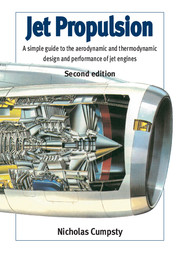 Jet Propulsion
Jet Propulsion Book contents
- Frontmatter
- Contents
- Preface
- Glossary
- Nomenclature
- Part 1 Design of Engines for a New 600-seat Aircraft
- Part 2 Engine Component Characteristics and Engine Matching
- Part 3 Design of Engines for a New Fighter Aircraft
- 13 A New Fighter Aircraft
- 14 Lift, Drag and the Effects of Manoeuvring
- 15 Engines for Combat Aircraft
- 16 Design Point for a Combat Engine
- 17 Combat Engines Off-design
- 18 Turbomachinery for Combat Engines
- Part 4 Return to the Civil Transport Engine
- Appendix: Noise and its Regulation
- Bibliography
- References
- Index
- Design sheets for New Large Civil Aircraft and New Fighter Aircraft
16 - Design Point for a Combat Engine
from Part 3 - Design of Engines for a New Fighter Aircraft
- Frontmatter
- Contents
- Preface
- Glossary
- Nomenclature
- Part 1 Design of Engines for a New 600-seat Aircraft
- Part 2 Engine Component Characteristics and Engine Matching
- Part 3 Design of Engines for a New Fighter Aircraft
- 13 A New Fighter Aircraft
- 14 Lift, Drag and the Effects of Manoeuvring
- 15 Engines for Combat Aircraft
- 16 Design Point for a Combat Engine
- 17 Combat Engines Off-design
- 18 Turbomachinery for Combat Engines
- Part 4 Return to the Civil Transport Engine
- Appendix: Noise and its Regulation
- Bibliography
- References
- Index
- Design sheets for New Large Civil Aircraft and New Fighter Aircraft
Summary
INTRODUCTION
In this chapter we will consider three separate engine designs corresponding to distinct operating conditions. For convenience here the three design points are at the tropopause (altitude 11 km; standard atmosphere temperature 216.65 K and pressure 22.7 kPa) for Mach numbers of 0.9, 1.5 and 2.0. The thrusts required for these conditions were determined in Exercise 14.4. At each condition a separate engine is designed – this is quite different from designing the engine for one condition and then considering its operation at different conditions, which is the topic of Chapter 17.
For this exercise all design points will correspond to the engine being required to produce maximum thrust, even though the ultimate suitability of an engine for its mission may depend on performance, particularly fuel consumption, at conditions for which the thrust is very much less than maximum. The designs will first be for engines without an afterburner (operation ‘dry’) and then with an afterburner; the afterburner will be assumed to raise the temperature of the exhaust without altering the operating condition of the remainder of the engine so the stagnation pressure entering the nozzle is unchanged.
The engines considered will all be of the mixed turbofan type – such an engine was shown in Fig. 15.1 with a sketch showing the station numbering system adopted. Note that the numbering shows station 13 downstream of the fan in the bypass and station 23 downstream of the fan for the core flow; in the present simplified treatment it will be assumed that p 023 = p 013 and that T 023 = T 013.
- Type
- Chapter
- Information
- Jet PropulsionA Simple Guide to the Aerodynamic and Thermodynamic Design and Performance of Jet Engines, pp. 221 - 241Publisher: Cambridge University PressPrint publication year: 2003


